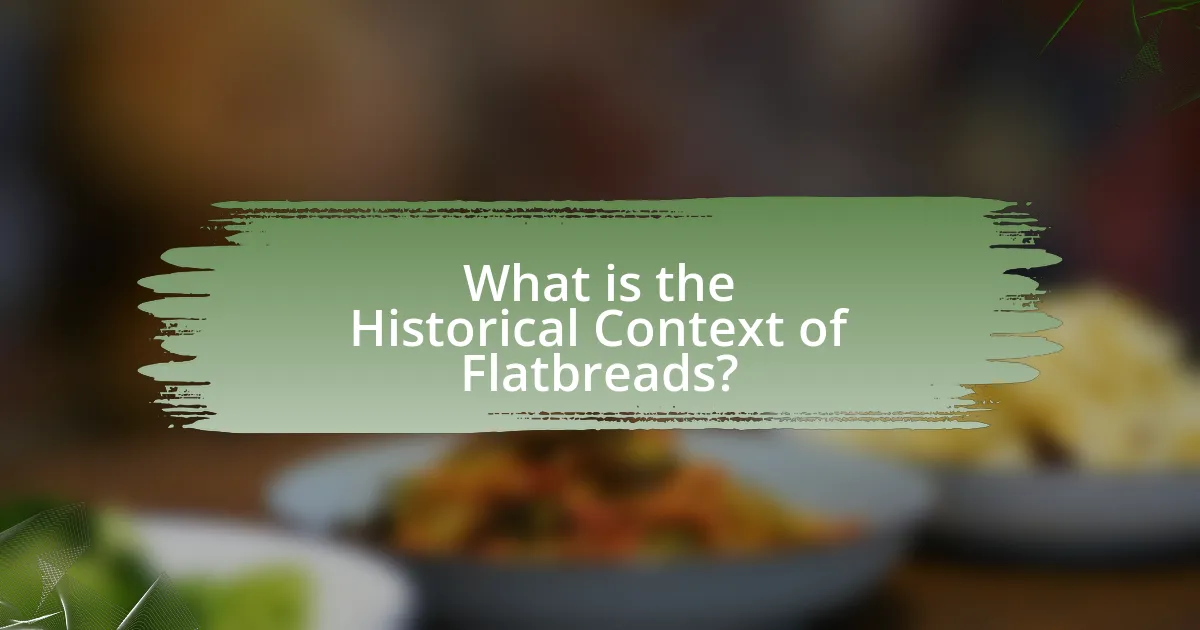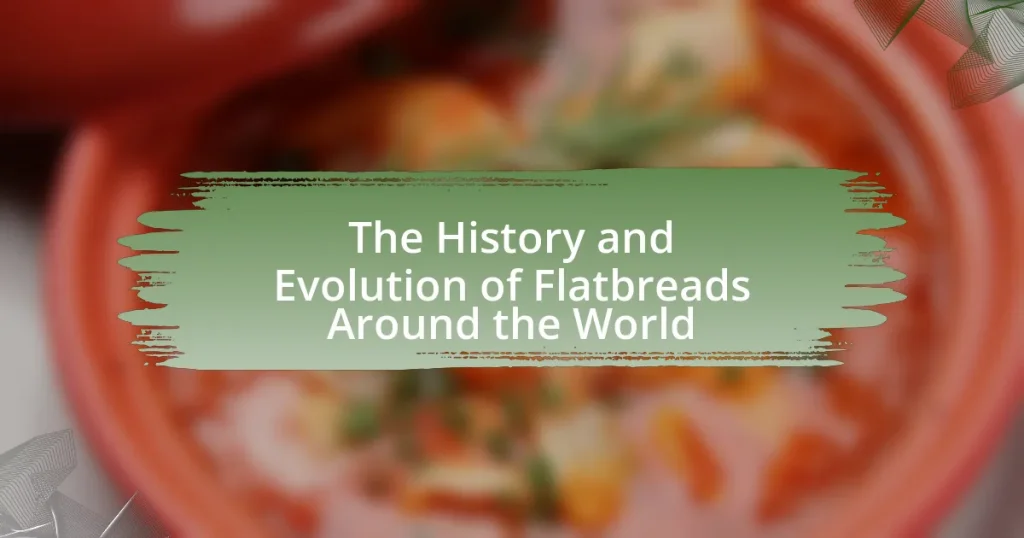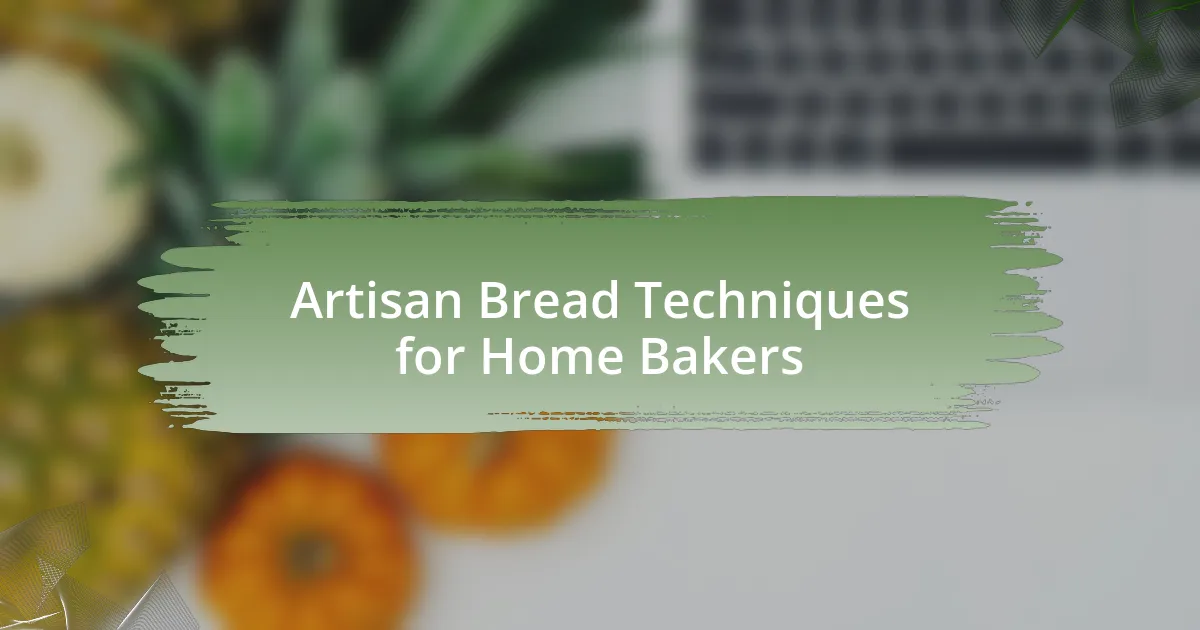Flatbreads are unleavened breads made from flour and water, with a rich history and cultural significance across global cuisines. This article explores the origins of flatbreads, tracing their development from ancient civilizations like Mesopotamia to their diverse forms today, such as naan, pita, and tortillas. It examines the characteristics that distinguish flatbreads from other types of bread, their role in dietary practices, and their importance in cultural rituals and communal dining. Additionally, the article highlights modern adaptations and innovations in flatbread production, providing insights into their continued relevance in contemporary diets.

What are Flatbreads and Their Significance in Global Cuisine?
Flatbreads are unleavened breads made from flour and water, rolled into flattened dough and baked, which have significant cultural and culinary importance across various global cuisines. Their simplicity and versatility allow them to serve as staples in many regions, such as naan in South Asia, pita in the Middle East, and tortillas in Latin America. Historically, flatbreads date back thousands of years, with evidence of their consumption found in ancient civilizations like the Egyptians and Mesopotamians, highlighting their role in human diet and social practices. The adaptability of flatbreads to local ingredients and cooking methods further underscores their significance, as they often accompany meals, serve as wraps, or act as utensils for scooping food, thus enhancing communal dining experiences.
How are flatbreads defined across different cultures?
Flatbreads are defined as unleavened breads made from flour and water, shaped into flat forms and cooked on a hot surface, varying significantly across cultures. In Middle Eastern cuisine, for example, pita is a staple, often used for dipping or wrapping, while in Indian culture, naan is a popular variant, typically leavened and cooked in a tandoor. In Italy, focaccia serves as a flatbread that is often seasoned with herbs and olive oil. Each culture adapts flatbreads to local ingredients and culinary practices, reflecting regional tastes and traditions. Historical evidence shows that flatbreads have been consumed for thousands of years, with archaeological findings indicating their presence in ancient civilizations such as Mesopotamia and Egypt, underscoring their global significance and cultural diversity.
What are the common characteristics of flatbreads?
Flatbreads are typically characterized by their thin, unleavened structure, which results in a chewy texture. They are made from a simple mixture of flour, water, and salt, often without the use of yeast or other leavening agents. This absence of leavening contributes to their flat appearance and allows for quick cooking methods, such as baking on hot surfaces or grilling. Common varieties include tortillas, pita, and naan, each reflecting regional ingredients and cooking techniques. The historical significance of flatbreads is evident as they have been a staple food in various cultures for thousands of years, serving as a versatile base for meals and a means of transportation for other foods.
How do flatbreads differ from other types of bread?
Flatbreads differ from other types of bread primarily in their preparation and texture. Unlike leavened breads, which use yeast or other agents to rise, flatbreads are typically unleavened, resulting in a denser and thinner product. This distinction is evident in various cultural examples, such as tortillas in Mexico and naan in India, which are made without yeast and cooked at high temperatures, leading to their characteristic flat shape. The absence of leavening agents in flatbreads contributes to their quick cooking time and versatility in serving as wraps or accompaniments to meals.
Why are flatbreads important in various culinary traditions?
Flatbreads are important in various culinary traditions because they serve as a staple food that is versatile and culturally significant. In many regions, flatbreads are used as a primary source of carbohydrates, often accompanying meals or serving as a base for other dishes. For example, in Middle Eastern cuisine, pita bread is commonly used to scoop up dips like hummus or to wrap fillings, reflecting its integral role in communal eating practices. Additionally, flatbreads have historical roots, with evidence of their consumption dating back thousands of years, such as the discovery of ancient flatbreads in archaeological sites in the Fertile Crescent. This historical significance underscores their enduring presence in diverse culinary practices across the globe.
What role do flatbreads play in cultural rituals and celebrations?
Flatbreads serve as essential components in various cultural rituals and celebrations across the globe. In many societies, flatbreads symbolize hospitality and community, often being shared during significant events such as weddings, religious ceremonies, and festivals. For instance, in Middle Eastern cultures, pita bread is commonly used in communal meals, reinforcing social bonds and cultural identity. Additionally, in Indian traditions, naan or roti is integral to celebrations like Diwali, where it accompanies festive dishes, highlighting its role in culinary heritage. Historical evidence shows that flatbreads have been present in rituals for thousands of years, with archaeological findings indicating their consumption in ancient civilizations, thus underscoring their enduring significance in cultural practices.
How do flatbreads contribute to dietary practices worldwide?
Flatbreads significantly contribute to dietary practices worldwide by serving as staple foods in various cultures, providing essential carbohydrates and nutrients. In regions such as the Middle East, India, and parts of Africa, flatbreads like pita, naan, and injera are integral to daily meals, often accompanying vegetables, meats, and legumes, thus enhancing nutritional balance. Historical evidence shows that flatbreads have been consumed for thousands of years, with archaeological findings indicating their presence in ancient civilizations, such as Mesopotamia around 14,000 years ago. This long-standing tradition underscores their role in food security and cultural identity, as flatbreads are often made from locally sourced grains, reflecting agricultural practices and regional tastes.

What is the Historical Context of Flatbreads?
Flatbreads have a historical context that dates back thousands of years, with evidence of their existence found in ancient civilizations such as Mesopotamia around 3000 BCE. Archaeological findings, including remnants of flatbreads in ancient ovens, indicate that these simple, unleavened breads were staples in the diets of early agricultural societies. The use of grains like wheat and barley in flatbread production reflects the agricultural practices of these civilizations, which laid the foundation for bread-making techniques that evolved over time. Additionally, flatbreads spread across cultures, adapting to local ingredients and cooking methods, which is evidenced by the variety of flatbreads found in regions such as the Middle East, India, and Europe.
When and where did flatbreads first originate?
Flatbreads first originated around 14,000 years ago in the region of the Fertile Crescent, which includes parts of modern-day Iraq, Syria, Lebanon, Israel, and Jordan. Archaeological evidence, such as charred remains of flatbreads found at ancient sites like Shubayqa 1 in Syria, supports this timeline and location, indicating that early humans were making these simple breads long before the advent of agriculture.
What archaeological evidence supports the history of flatbreads?
Archaeological evidence supporting the history of flatbreads includes the discovery of ancient grinding stones and charred flatbread remnants at sites such as Çatalhöyük in Turkey, dating back to approximately 7500 BCE. These findings indicate that early agricultural societies were producing and consuming flatbreads as a staple food. Additionally, the presence of wheat and barley grains in archaeological layers further corroborates the cultivation of these grains for flatbread production in ancient civilizations.
How did ancient civilizations utilize flatbreads?
Ancient civilizations utilized flatbreads as a staple food source, serving various purposes in their diets. For instance, in Mesopotamia, flatbreads were made from barley and wheat, providing essential carbohydrates and nutrients. These breads often accompanied meals, acting as a utensil to scoop up food, which was common in cultures such as the Egyptians, who also used flatbreads in religious rituals and offerings. Additionally, flatbreads were portable, making them ideal for nomadic tribes, who relied on them during migrations. Historical evidence, such as archaeological findings of ancient ovens and bread remnants, supports the significance of flatbreads in daily life and cultural practices across these civilizations.
How have flatbreads evolved over time?
Flatbreads have evolved significantly over time, transitioning from simple, unleavened doughs to diverse varieties that incorporate leavening agents and regional ingredients. Initially, ancient civilizations such as the Sumerians and Egyptians created flatbreads using basic grains like barley and wheat, which were cooked on hot stones or in ashes. As agriculture advanced, the introduction of yeast and fermentation processes led to the development of leavened flatbreads, such as pita and naan, which became staples in various cultures. The globalization of trade further diversified flatbread recipes, incorporating local flavors and techniques, resulting in a wide array of flatbreads like tortillas in Mexico and focaccia in Italy. This evolution reflects both technological advancements in food preparation and the cultural exchanges that shaped culinary practices worldwide.
What historical events influenced the development of flatbreads?
The development of flatbreads was significantly influenced by agricultural advancements and the rise of ancient civilizations. The domestication of wheat and other grains around 10,000 BCE in the Fertile Crescent allowed for the production of flour, which was essential for making flatbreads. Additionally, the establishment of trade routes, such as the Silk Road, facilitated the exchange of ingredients and baking techniques, further shaping flatbread varieties across different cultures. Historical records indicate that ancient Egyptians baked flatbreads as early as 3000 BCE, showcasing the importance of flatbreads in daily diets and rituals.
How did trade routes affect the spread of flatbread recipes?
Trade routes significantly facilitated the spread of flatbread recipes by enabling cultural exchange and the movement of ingredients. As merchants traveled along routes such as the Silk Road, they not only transported goods but also shared culinary practices and techniques. For instance, the introduction of wheat from the Fertile Crescent to regions like Europe and Asia led to the adaptation of local flatbread recipes, incorporating regional flavors and cooking methods. Historical evidence shows that as trade flourished, variations of flatbread emerged, such as naan in South Asia and focaccia in Italy, reflecting the influence of diverse cultures on this staple food.

What are the Different Types of Flatbreads Around the World?
Flatbreads are diverse types of unleavened breads that vary significantly across cultures and regions. Common types include naan from South Asia, which is typically cooked in a tandoor; pita from the Middle East, known for its pocket; tortillas from Mexico, made from corn or wheat; lavash from Armenia, a thin, soft bread; and focaccia from Italy, which is thicker and often topped with herbs. Each type of flatbread has unique preparation methods and cultural significance, reflecting the culinary traditions of their respective regions. For instance, naan has been a staple in Indian cuisine for centuries, while pita has roots in ancient Middle Eastern civilizations.
What are some popular flatbreads from various regions?
Some popular flatbreads from various regions include naan from South Asia, pita from the Middle East, and tortillas from Mexico. Naan is a leavened flatbread traditionally baked in a tandoor, often served with curries. Pita is a round, pocket-style flatbread that is commonly used for sandwiches and dips like hummus. Tortillas, made from corn or wheat, are essential in Mexican cuisine, serving as a base for tacos and enchiladas. Each of these flatbreads has deep cultural significance and historical roots in their respective regions, reflecting local ingredients and culinary practices.
How is naan prepared and served in South Asian cuisine?
Naan is prepared in South Asian cuisine by mixing flour, water, yeast, and yogurt to create a soft dough, which is then allowed to rise. After the dough has risen, it is divided into small balls, rolled out into flat rounds, and traditionally cooked in a tandoor, a clay oven, which gives naan its characteristic charred flavor and texture. Naan is typically served hot, often brushed with ghee or butter, and can be accompanied by various dishes such as curries, dals, or served plain or stuffed with ingredients like garlic or cheese. The use of a tandoor for cooking naan dates back centuries, highlighting its significance in South Asian culinary traditions.
What distinguishes pita bread in Middle Eastern dishes?
Pita bread is distinguished in Middle Eastern dishes by its unique pocket structure, which allows it to be easily filled with various ingredients. This characteristic is a result of the high moisture content in the dough and the baking process, where the bread puffs up in the oven, creating a hollow center. Historically, pita has been a staple in Middle Eastern cuisine for thousands of years, serving as a versatile accompaniment to dishes such as falafel, shawarma, and various dips like hummus and baba ghanoush. The use of pita bread enhances the dining experience by providing a convenient way to scoop and enjoy flavorful foods, making it an integral part of the region’s culinary identity.
How do ingredients and preparation methods vary among flatbreads?
Ingredients and preparation methods among flatbreads vary significantly based on regional traditions and available resources. For instance, Middle Eastern flatbreads like pita are typically made from wheat flour, water, and yeast, resulting in a leavened bread that puffs up during baking. In contrast, Indian flatbreads such as chapati use whole wheat flour and water, cooked on a hot griddle without leavening, producing a dense, unleavened bread. Additionally, some flatbreads, like Italian focaccia, incorporate olive oil and herbs, while others, such as Mexican tortillas, may use corn or wheat flour, reflecting local agricultural practices. These variations illustrate how cultural influences and ingredient availability shape the diversity of flatbreads globally.
What are the common ingredients used in flatbread recipes?
Common ingredients used in flatbread recipes include flour, water, and salt. These basic components form the foundation of most flatbreads, with variations often incorporating additional ingredients such as yeast, baking powder, or milk to alter texture and flavor. Historical evidence shows that ancient civilizations, including the Egyptians and Mesopotamians, utilized these ingredients to create flatbreads, highlighting their longstanding significance in global culinary traditions.
How does the cooking technique impact the texture of flatbreads?
The cooking technique significantly impacts the texture of flatbreads by influencing moisture retention, crust formation, and overall chewiness. For instance, baking flatbreads in a tandoor oven creates a crispy exterior while maintaining a soft interior due to the high, direct heat, which rapidly cooks the dough. Conversely, cooking flatbreads on a griddle or skillet allows for a more even cooking process, resulting in a softer texture with less pronounced crust. Additionally, steaming flatbreads yields a tender and pliable texture, as seen in varieties like bao or mantou. These variations in cooking methods directly correlate with the final texture, demonstrating that the technique chosen is crucial in defining the sensory experience of flatbreads.
What are some modern adaptations of traditional flatbreads?
Modern adaptations of traditional flatbreads include variations such as gluten-free options, whole grain versions, and the incorporation of diverse toppings and fillings. For instance, cauliflower crusts have emerged as a popular gluten-free alternative to traditional pizza bases, while whole wheat and spelt flatbreads cater to health-conscious consumers seeking more nutritious choices. Additionally, flatbreads are now often topped with gourmet ingredients like artisanal cheeses, exotic spices, and seasonal vegetables, reflecting contemporary culinary trends and preferences. These adaptations demonstrate the versatility of flatbreads, allowing them to evolve while maintaining their cultural significance.
How are flatbreads being incorporated into contemporary diets?
Flatbreads are increasingly being incorporated into contemporary diets as versatile alternatives to traditional bread, often used in various culinary applications such as wraps, pizzas, and as accompaniments to meals. Their popularity is driven by the rise of health-conscious eating, with many flatbreads being made from whole grains, gluten-free ingredients, or ancient grains, appealing to dietary preferences and restrictions. For instance, the global market for flatbreads is projected to grow significantly, reflecting their integration into diverse cuisines and meal patterns, as seen in the increasing availability of products like whole wheat naan and gluten-free tortillas in supermarkets.
What innovations have emerged in flatbread production?
Innovations in flatbread production include the use of automated machinery for mixing, rolling, and baking, which enhances efficiency and consistency. Additionally, advancements in fermentation techniques, such as the use of sourdough starters and controlled fermentation processes, have improved flavor and texture. The introduction of gluten-free and alternative grain options, like chickpea and quinoa flour, has expanded the market to cater to dietary restrictions. Furthermore, the development of pre-packaged flatbreads with extended shelf life through modified atmosphere packaging has increased convenience for consumers. These innovations reflect a response to consumer demand for quality, variety, and convenience in flatbread products.
What are some tips for making flatbreads at home?
To make flatbreads at home, start with a simple dough using flour, water, and salt, ensuring the ingredients are well combined for a smooth texture. Knead the dough for about 5-10 minutes to develop gluten, which provides elasticity and chewiness. Allow the dough to rest for at least 30 minutes, as this relaxes the gluten and makes rolling easier. Roll the dough into thin rounds for even cooking, and cook on a hot skillet or griddle for 1-2 minutes on each side until puffed and lightly browned. Using a high heat ensures the flatbreads cook quickly, maintaining their softness. These techniques are supported by traditional practices in various cultures, where flatbreads have been made for centuries, emphasizing the importance of dough preparation and cooking methods.
What essential tools and ingredients do you need for homemade flatbreads?
To make homemade flatbreads, you need essential tools and ingredients including flour, water, salt, and a cooking surface like a skillet or griddle. Flour serves as the primary ingredient, providing the structure, while water hydrates the flour to form dough. Salt enhances flavor and strengthens the dough’s gluten structure. A skillet or griddle is necessary for cooking the flatbreads evenly. Historically, flatbreads have been made with simple ingredients, reflecting their widespread availability and ease of preparation across various cultures.
How can you troubleshoot common issues when making flatbreads?
To troubleshoot common issues when making flatbreads, first identify the specific problem, such as dough not rising, flatbreads being too tough, or uneven cooking. For dough not rising, ensure that yeast is fresh and properly activated; using warm water (around 110°F) can help. If flatbreads are tough, check that the dough is not over-kneaded and that it has adequate resting time to relax gluten. For uneven cooking, ensure the cooking surface is preheated evenly and adjust the cooking time or temperature as needed. These troubleshooting steps are based on standard baking practices that enhance the quality of flatbreads.




